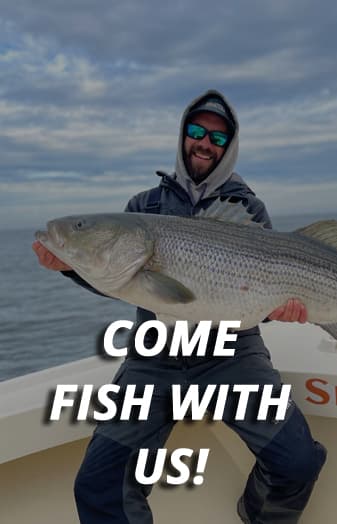Windows of Opportunity
Be ready to roll when sports of good weather sneak up on the Chesapeake Bay this winter
While many anglers in the Mid-Atlantic and Chesapeake Bay region call it quits for the fishing season in late fall, die-hard and opportunistic fisherman are just hitting their stride. Shrink-wrapping boats and winterizing outboards don’t have to be your only options as a striped bass angler. Small windows of good weather throughout the winter season allow many fishermen to sneak out and enjoy great catch and release fishing for striped bass.
Cold Water Haunts
Hunting striped bass, or rockfish, in their wintering grounds can be difficult if you don’t know where to start. In order to high-grade to the most promising spots at this time of year, focus your angling efforts on three key areas – Bay wintering grounds, inshore ocean shoals, and literal hot spots.
As the water temperatures cool, Bay resident fish congregate and pull out of the many rivers into the Bay where they spend their summer months. Pushing south with cooling water temperatures, these fish are searching for suitable conditions and the chance to fatten up before their metabolism slows. Deep-water portions of the lower Chesapeake in Maryland and Virginia waters will stack up fat, football-shaped striped bass. These wintering areas that hold bait and fish alike would be the best place to start hunting.
On the other side of the Delmarva Peninsula, just like their smaller counterparts in the Bay, the migratory fish are also pushing south out of their New England summer grounds. Some migratory fish slide into the very lower portions of the Chesapeake Bay searching out bait but many will winter over in close proximity to the entrance of the Bay in near-shore waters along the coastline. Finding these bigger fish can be much more difficult, with an expansive amount of territory to cover. Searching near-shore shoals and location schools of bait are your most productive tactics in the ocean. Finally, another winter approach is fishing one of the warm-water outflows into the Bay. Typically, from Maryland’s western shore of the Chesapeake, industrial and power plant discharges can be productive hiding sports, these areas can produce quality winter fish, but approaching these hot spots requires caution and stealth.
On the Menu
Winter fish are focused on primarily two sources of bait – bunker and sand eels. In the Chesapeake, bunker, or Atlantic menhaden, are high on the menu. Tightly packed schools of bunker are laying low, trying to avoid predation in their open-water winter homes. Sand eels and bunker schools feed the migratory fish as the migration pushes south.
Noticing what the fish are eating will greatly help with the lure selection, color, and size. Jigging soft plastics like the Hogy 7-inch HDUV bait is an effective way to imitate most of what is on the striped bass winter diet. Jigging, metal spoons, feeling, and trolling can also be very productive. If fish are spread out over a large area, trolling or casting “search baits” like heavy paddle tails can be a great way to put a bend in the rod.
Tightly packed school fish are more effectively jigged where the bait can remain in the strike zone longer. Quickly identifying what the fish are feeding on will allow you to better select the appropriate size bait and tactics that will maximize your time during shorter winter feeds.
Weather and Safety
Fishing during the winter months can be incredibly fun and a great cure for cabin fever. However, keeping a close eye on the weather and sea conditions is of the utmost importance during these months. Hypothermia and dangerous seas are a threat to the winter angler that simply cannot be ignored, and caution must be exercised.
Dressing with the right gear is a key aspect in having a fun, successful trip. Quality outerwear and laying are a must. Even if the temperature feels comfortable at the ramp, the test will come on long rides and through unexpected weather. Showing up for a winter trip in jeans and a hooded sweatshirt is not going to cut it, especially on a center console. Full foul-weather gear is crucial even on blue bird winter days, and it starts with heavy-duty, waterproof outerwear.
Watching the weather and dressing correctly for winter fishing is a lesson you might not get a second chance to learn the hard way.
Eye on the Regs
Fishing through the winter months in the Chesapeake region can pay off, with large numbers of fat resident fish and the newfound influx of large, migratory fish. When legal, harvesting the correct fish for dinner is a rewarding and great way to celebrate a productive trip with friends. But safely releasing striped bass now, more than ever, is a great way to ensure these fish for the future.
Striper fishing in the ocean past three miles is, of course, illegal, and ongoing regulation changes in the last year are aimed at further conservation of these fish. Knowing the latest regulations in your area of fishing should be regarded right alongside your waterproof outerwear and fishing tackle as standard gear. Recreational anglers have a responsibility to be good stewards of the marine resource. Abiding by the rules and adhering to best fishing practices ensures that anglers will be able to enjoy our amazing striped bass resource for generations to come.



